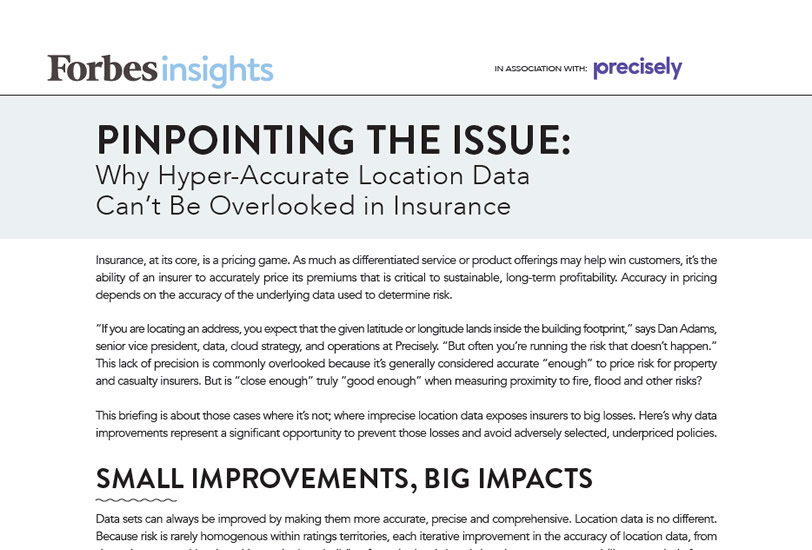Analyst Report
Pinpointing the Issue: Why Hyper-Accurate Location Data Can’t Be Overlooked in Insurance
Accurate location data for insurance – small improvements – big impacts
Insurance, at its core, is a pricing game. As much as differentiated service or product offerings may help win customers, it’s the ability of an insurer to accurately price its premiums that is critical to sustainable, long-term profitability. Accuracy in pricing depends on the accurate location data used to determine risk. “If you are locating an address, you expect that the given latitude or longitude lands inside the building footprint,” says Dan Adams, senior vice president, data, cloud strategy, and operations at Precisely. “But often you’re running the risk that doesn’t happen.”
This lack of precision is commonly overlooked because it’s generally considered accurate “enough” to price risk for property and casualty insurers. But is “close enough” truly “good enough” when measuring proximity to fire, flood and other risks? This briefing is about those cases where it’s not; where imprecise location data exposes insurers to big losses. Here’s why data improvements represent a significant opportunity to prevent those losses and avoid adversely selected, underpriced policies.
Datasets can always be improved by making them more accurate, precise and comprehensive. Location data is no different. Because risk is rarely homogenous within ratings territories, each iterative improvement in the accuracy of location data, from ZIP Codes to parcel-level, and increasingly to building footprint-level data, brings insurers a greater ability to precisely factor risk. But how much is that ability actually worth?
To answer that question, we can turn to research carried out by Perr&Knight and commissioned by Precisely. In two studies, the actuarial consulting firm looked at typical auto and homeowner insurance policies to compare how premiums would be priced under commonly used vendor data sets—like ZIP Codes and street segments—versus under more precise parcel-level data.
With the latter approach, this meant a home’s actual site or an automobile’s actual garaging location was used to determine risk rather than a more general, nearby point. The research found that although most policies would experience no change in pricing, in the 5% to 10% of cases that would, the range of under- or overpricing in premiums was significant. Some homeowner policies were underpriced by as much as 86.7%, or $2,800 a year per policy.
This whitepaper explores how accurate location data represents opportunities to prevent losses and avoid adversely selected, underpriced policies. Read more.
